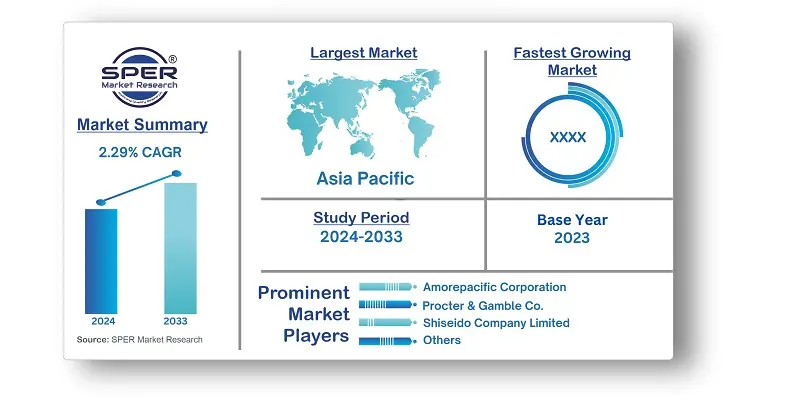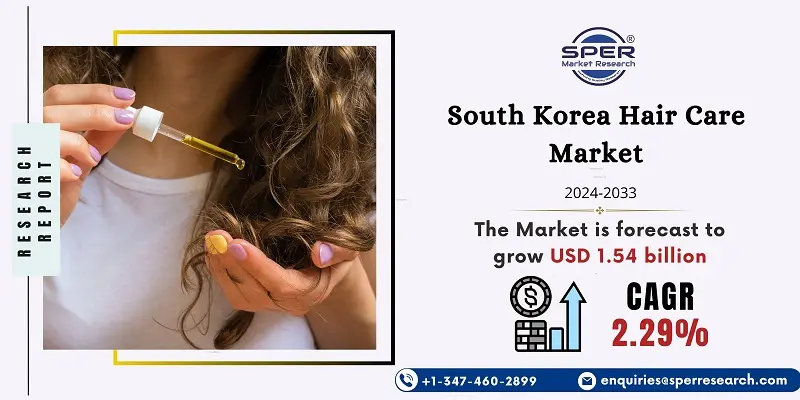
South Korea Hair Care Market Trends, Share, Demand, Revenue, Competition and Future Outlook
South Korea Hair Care Market Growth, Size, Trends Analysis- By Product Type, By Distribution Channel- Regional Outlook, Competitive Strategies and Segment Forecast to 2033
| Published: Nov-2024 | Report ID: FMCG24196 | Pages: 1 - 108 | Formats*: |
| Category : Consumer & Retail | |||
- The South Korean stem cell technology business SCM Lifescience Inc. and Duopharma Biotech Bhd, through its wholly-owned subsidiary Duopharma Consumer Healthcare Sdn Bhd, signed a product distribution agreement in September 2022 for the marketing of a variety of anti-hair loss treatments in Malaysia.
- The successful launches of shampoos that can cover up grey hairs by South Korean cosmetic giants Amorepacific and LG Household & Healthcare (LG H&H) in June 2022 indicate a significant market for anti-aging hair care products.


| Report Metric | Details |
| Market size available for years | 2020-2033 |
| Base year considered | 2023 |
| Forecast period | 2024-2033 |
| Segments covered | By Product Type, By Distribution Channel. |
| Regions covered | Eastern Region, Western Region, Southern Region, Northern Region. |
| Companies Covered | Amorepacific Corporation, LG Household & Health Care Ltd, Tony Moly, Nature Republic Inc, Kao Corporation, Procter & Gamble Co, AEKYUNG Industry Co. Ltd, Mandom Corporation, Henkel AG & Co. KGaA, Shiseido Company Limited. |
- Young Adults and Millennials
- Aging Population
- Beauty and Wellness Enthusiasts
- Men’s Grooming Segment
- K-Beauty Influencers and Content Creators
- Retailers and E-Commerce Platforms
- Salons and Professional Stylists
| By Product Type: | |
| By Distribution Channel: |
- South Korea Hair Care Market Size (FY’2024-FY’2033)
- Overview of South Korea Hair Care Market
- Segmentation of South Korea Hair Care Market By Product Type (Shampoo, Conditioner, Hair Spray, Serum, and Others)
- Segmentation of South Korea Hair Care Market By Distribution Channel (Supermarkets, Convenience Stores, Specialty Stores, Online Retail Stores, and Others)
- Statistical Snap of South Korea Hair Care Market
- Expansion Analysis of South Korea Hair Care Market
- Problems and Obstacles in South Korea Hair Care Market
- Competitive Landscape in the South Korea Hair Care Market
- Impact of COVID-19 and Demonetization on South Korea Hair Care Market
- Details on Current Investment in South Korea Hair Care Market
- Competitive Analysis of South Korea Hair Care Market
- Prominent Players in the South Korea Hair Care Market
- SWOT Analysis of South Korea Hair Care Market
- South Korea Hair Care Market Future Outlook and Projections (FY’2024-FY’2033)
- Recommendations from Analyst
1.1. Scope of the report1.2. Market segment analysis
2.1. Research data source
2.1.1. Secondary Data2.1.2. Primary Data2.1.3. SPERs internal database2.1.4. Premium insight from KOLs
2.2. Market size estimation
2.2.1. Top-down and Bottom-up approach
2.3. Data triangulation
4.1. Driver, Restraint, Opportunity and Challenges analysis
4.1.1. Drivers4.1.2. Restraints4.1.3. Opportunities4.1.4. Challenges
4.2. COVID-19 Impacts of the South Korea Hair Care Market.
5.1. SWOT Analysis
5.1.1. Strengths5.1.2. Weaknesses5.1.3. Opportunities5.1.4. Threats
5.2. PESTEL Analysis
5.2.1. Political Landscape5.2.2. Economic Landscape5.2.3. Social Landscape5.2.4. Technological Landscape5.2.5. Environmental Landscape5.2.6. Legal Landscape
5.3. PORTERs Five Forces
5.3.1. Bargaining power of suppliers5.3.2. Bargaining power of buyers5.3.3. Threat of Substitute5.3.4. Threat of new entrant5.3.5. Competitive rivalry
5.4. Heat Map Analysis
6.1. South Korea Hair Care Market Manufacturing Base Distribution, Sales Area, Product Type6.2. Mergers & Acquisitions, Partnerships, Product Launch, and Collaboration in South Korea Hair Care Market
7.1. South Korea Hair Care Market Size, Share and Forecast, By Product Type, 2020-20267.2. South Korea Hair Care Market Size, Share and Forecast, By Product Type, 2027-20337.3. Shampoo7.4. Conditioner7.5. Hair Spray7.6. Serum7.7. Others
8.1. South Korea Hair Care Market Size, Share and Forecast, By Distribution Channel, 2020-20268.2. South Korea Hair Care Market Size, Share and Forecast, By Distribution Channel, 2027-20338.3. Supermarkets8.4. Convenience Stores8.5. Drug Stores8.6. Specialty Stores8.7. Online Retail Stores8.8. Others
9.1. South Korea Hair Care Market Size and Market Share
10.1. South Korea Hair Care Market Size and Market Share By Region (2020-2026)10.2. South Korea Hair Care Market Size and Market Share By Region (2027-2033)10.3. Eastern Region10.4. Western Region10.5. Southern Region10.6. Northern Region
11.1. Amorepacific Corporation
11.1.1. Company details11.1.2. Financial outlook11.1.3. Product summary11.1.4. Recent developments
11.2. LG Household & Health Care Ltd
11.2.1. Company details11.2.2. Financial outlook11.2.3. Product summary11.2.4. Recent developments
11.3. Tony Moly
11.3.1. Company details11.3.2. Financial outlook11.3.3. Product summary11.3.4. Recent developments
11.4. Nature Republic Inc
11.4.1. Company details11.4.2. Financial outlook11.4.3. Product summary11.4.4. Recent developments
11.5. Kao Corporation
11.5.1. Company details11.5.2. Financial outlook11.5.3. Product summary11.5.4. Recent developments
11.6. Procter & Gamble Co
11.6.1. Company details11.6.2. Financial outlook11.6.3. Product summary11.6.4. Recent developments
11.7. AEKYUNG Industry Co. Ltd
11.7.1. Company details11.7.2. Financial outlook11.7.3. Product summary11.7.4. Recent developments
11.8. Mandom Corporation
11.8.1. Company details11.8.2. Financial outlook11.8.3. Product summary11.8.4. Recent developments
11.9. Henkel AG & Co. KGaA
11.9.1. Company details11.9.2. Financial outlook11.9.3. Product summary11.9.4. Recent developments
11.10. Shiseido Company Limited
11.10.1. Company details11.10.2. Financial outlook11.10.3. Product summary11.10.4. Recent developments
11.11. Others
SPER Market Research’s methodology uses great emphasis on primary research to ensure that the market intelligence insights are up to date, reliable and accurate. Primary interviews are done with players involved in each phase of a supply chain to analyze the market forecasting. The secondary research method is used to help you fully understand how the future markets and the spending patterns look likes.
The report is based on in-depth qualitative and quantitative analysis of the Product Market. The quantitative analysis involves the application of various projection and sampling techniques. The qualitative analysis involves primary interviews, surveys, and vendor briefings. The data gathered as a result of these processes are validated through experts opinion. Our research methodology entails an ideal mixture of primary and secondary initiatives.



Frequently Asked Questions About This Report
PLACE AN ORDER
Year End Discount
Sample Report
Pre-Purchase Inquiry
NEED CUSTOMIZATION?
Request CustomizationCALL OR EMAIL US
100% Secure Payment






Related Reports
Our Global Clients
Our data-driven insights have influenced the strategy of 200+ reputed companies across the globe.




















